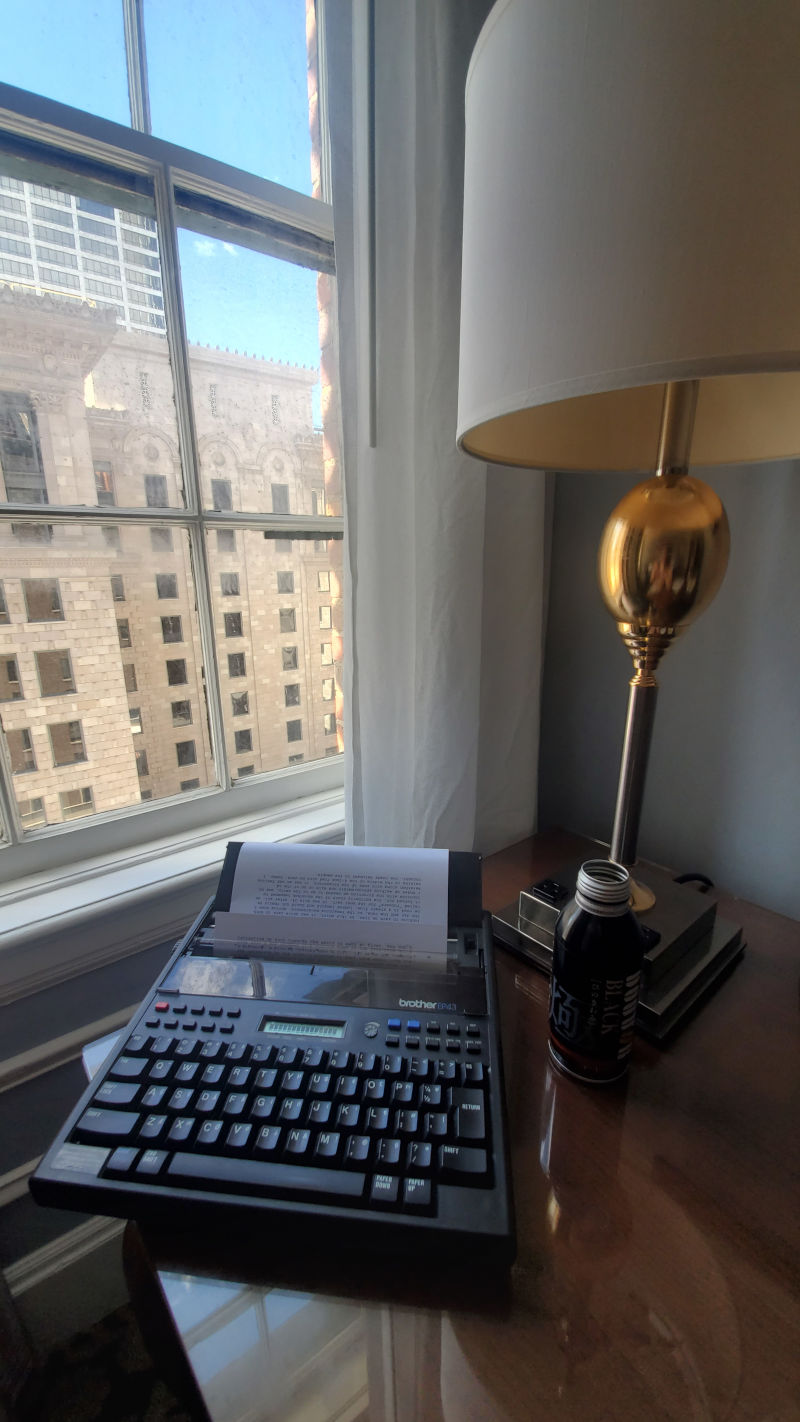 one thing i'm grateful for is the miraculous survival of long-distance passenger rail in the united states, albeit it is mostly thanks to heavy financial support from the federal government. i have no issue with that because in my opinion it is probably the best usage of my (admittedly meager) taxpayer dollars. trains are my perfect mode of transportation because i'm afflicted with an insatiable curiosity for the world passing by, a condition which unfortunately makes me a menace on the roads because i constantly get distracted looking around at things. riding the train allows me to indulge to such excess that my neck begins to ache from being turned towards the window for so long. compared to roads, railway routes also provide many new perspectives: in the mountains, they tend to run much higher along the mountainsides than roads, and by the sea, they run closer to the water. in cities, trains run through the "behind-the-scenes" back areas, industrial areas with tangles of pipes and belts and rows of tanks, massive warehouses, outdoor storage yards containing massive quantities of every large object imaginable: garden ceramics, precarious pallet piles, barrels, shipping containers, vehicles of all sorts and in every condition, lawn mowers, trash cans. the mysterious origins of commonplace props you've always taken for granted are finally brought to light - where do all those concrete highway barricades come from? off a giant stack of them in a gravel lot on the outskirts of town. where do amazon packages come from? huge logistics warehouses with blue highlights and no windows but hundreds of loading docks. oh, and the train is also the only place where it's possible to dine on one of my favorite foods, the amtrak signature flat iron steak, a culinary wonder which has no right to exist on the rails. one of these days i must write a dedicated tribute to amtrak, but now is not the time...
one thing i'm grateful for is the miraculous survival of long-distance passenger rail in the united states, albeit it is mostly thanks to heavy financial support from the federal government. i have no issue with that because in my opinion it is probably the best usage of my (admittedly meager) taxpayer dollars. trains are my perfect mode of transportation because i'm afflicted with an insatiable curiosity for the world passing by, a condition which unfortunately makes me a menace on the roads because i constantly get distracted looking around at things. riding the train allows me to indulge to such excess that my neck begins to ache from being turned towards the window for so long. compared to roads, railway routes also provide many new perspectives: in the mountains, they tend to run much higher along the mountainsides than roads, and by the sea, they run closer to the water. in cities, trains run through the "behind-the-scenes" back areas, industrial areas with tangles of pipes and belts and rows of tanks, massive warehouses, outdoor storage yards containing massive quantities of every large object imaginable: garden ceramics, precarious pallet piles, barrels, shipping containers, vehicles of all sorts and in every condition, lawn mowers, trash cans. the mysterious origins of commonplace props you've always taken for granted are finally brought to light - where do all those concrete highway barricades come from? off a giant stack of them in a gravel lot on the outskirts of town. where do amazon packages come from? huge logistics warehouses with blue highlights and no windows but hundreds of loading docks. oh, and the train is also the only place where it's possible to dine on one of my favorite foods, the amtrak signature flat iron steak, a culinary wonder which has no right to exist on the rails. one of these days i must write a dedicated tribute to amtrak, but now is not the time...
when i booked my first train trip several years ago, in doing so i surrendered my email to the mailing list of the National Railroad Passenger Corporation d/b/a Amtrak(R). in exchange for putting up with months of mindless marketing, they periodically inform me of good deals like the reliable old 2-for-1 sleeper car sale that comes around every six months or so. the only issue is that it requires convincing someone else to come with me, but luckily i already had someone on deck the latest time the deal came around, so i booked a train trip several months out in a direction i'd never been in, down south across california (the alternative option is always chicago, where all railroads in the US lead).
as the trip grew nearer, it started to gain unintended significance as a chance to regain my mojo, because in the intervening months i had come down with a mysterious debilitating nervous complaint (possibly a brief case of long covid?) that scrambled my brains into mashed potatoes and left me moping around the house unable to do much of anything, only partially alleviated by even science's strongest exorcistic ritual (the MRI scan). i considered bailing out but the fact that i wasn't going alone made it difficult, the poor boy would never make it in the city without me (i'm sure he thought the same regarding me). so, despite my reservations, when the day came i packed up and headed for the train station, hoping that maybe it might even end up being just what i needed to snap myself out of it...
san jose diridon transit center
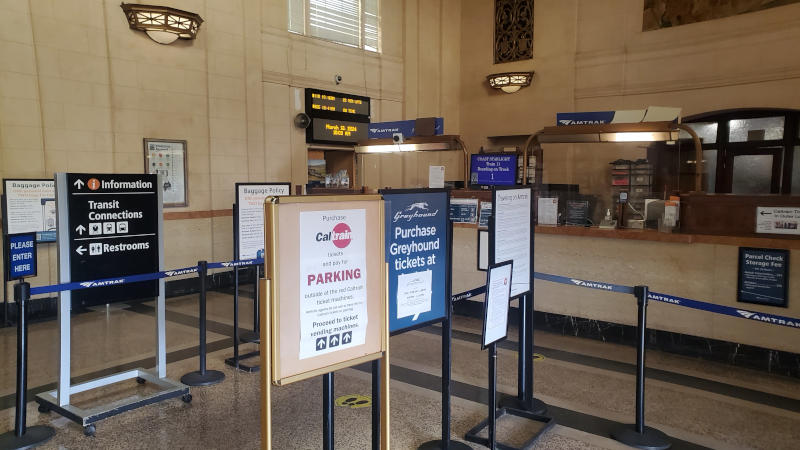
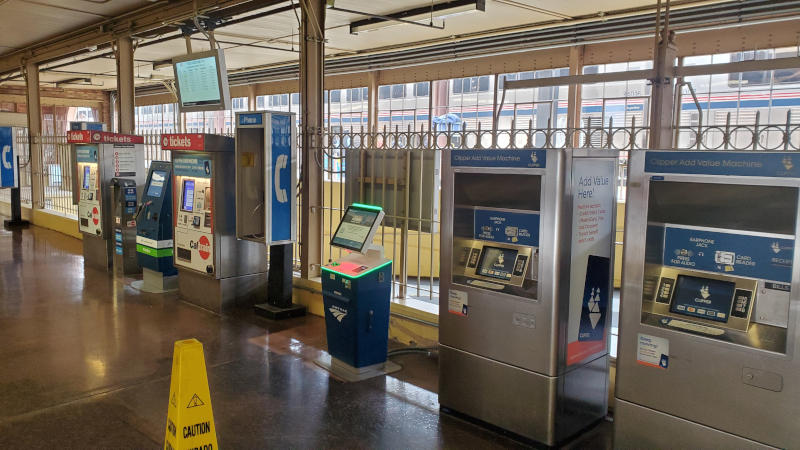 long-distances trains make an extended station stop every few hours to refill on supplies and as a "fresh air/smoke break", during which i like to get out and have a look around the train stations of america. the most memorable stop along the way was at the san jose diridon "transit center", in the heart of silicon valley. san jose has the most expensive housing market in the entire country, but you'd never be able to tell from the train station, you might as well be in detroit (the san jose of yesteryear, when computers were cars). the station had a very particular aesthetic that arises when chronically-underfunded government agencies operate out of grand old historic buildings, costly classical elegance clashing with modern cost-cutting like mass-produced standardized signage and furniture. as a "transit center", the station was shared between five or six different transit services, each of whom made their own contributions to a grove of info signs and a diverse ticket machine line-up by the platform. to complete the atmosphere, at five minute intervals a robotic voice intoned "expect major delays for all trains due to [INCIDENT]", though according to video monitors all trains were "ON TIME". there was not a single employee of anything to be found within the station, not even a janitor, so the intrepid traveler trying to figure out how to get somewhere was left to puzzle through the cacophony of posted information left in the station like the desperate cryptic warnings of some long-gone precursor civilization. not wanting to be left behind in such a purgatory, i made my way back to the train without lingering and decompressed with approximately six hours of leisurely riding through what was essentially the landscape from the default windows XP wallpaper (thanks to an exceptionally wet winter this year).
long-distances trains make an extended station stop every few hours to refill on supplies and as a "fresh air/smoke break", during which i like to get out and have a look around the train stations of america. the most memorable stop along the way was at the san jose diridon "transit center", in the heart of silicon valley. san jose has the most expensive housing market in the entire country, but you'd never be able to tell from the train station, you might as well be in detroit (the san jose of yesteryear, when computers were cars). the station had a very particular aesthetic that arises when chronically-underfunded government agencies operate out of grand old historic buildings, costly classical elegance clashing with modern cost-cutting like mass-produced standardized signage and furniture. as a "transit center", the station was shared between five or six different transit services, each of whom made their own contributions to a grove of info signs and a diverse ticket machine line-up by the platform. to complete the atmosphere, at five minute intervals a robotic voice intoned "expect major delays for all trains due to [INCIDENT]", though according to video monitors all trains were "ON TIME". there was not a single employee of anything to be found within the station, not even a janitor, so the intrepid traveler trying to figure out how to get somewhere was left to puzzle through the cacophony of posted information left in the station like the desperate cryptic warnings of some long-gone precursor civilization. not wanting to be left behind in such a purgatory, i made my way back to the train without lingering and decompressed with approximately six hours of leisurely riding through what was essentially the landscape from the default windows XP wallpaper (thanks to an exceptionally wet winter this year).
DTLA
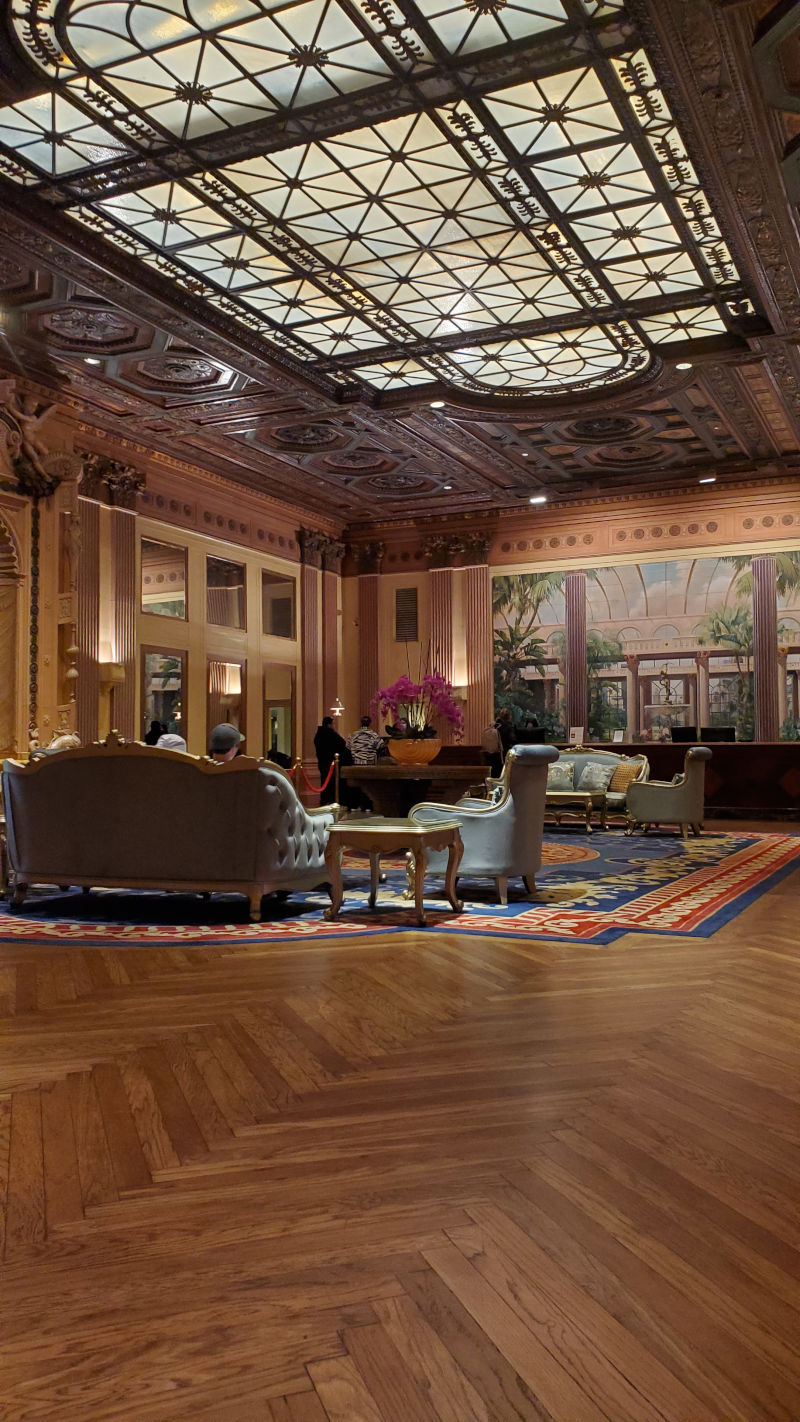 DTLA (DownTown Los Angeles) is the model of the modern american downtown, juxtaposing society's extreme highs and lows: up in the highrises are the beautiful people and their luxury apartments, slick offices, trendy restaurants, hip clubs; at street level, a pervasive population of
DTLA (DownTown Los Angeles) is the model of the modern american downtown, juxtaposing society's extreme highs and lows: up in the highrises are the beautiful people and their luxury apartments, slick offices, trendy restaurants, hip clubs; at street level, a pervasive population of homeless people hoboes vagrants bums houseless people unhoused people persons experiencing unhousedness homeless people. the contrast felt especially stark because i managed to book an unusually swanky downtown hotel at an improbably low price, the biltmore hotel (which i nicknamed "the giltmore"), so we'd walk in from the grimy public square/metro exit (a local homeless hotspot) into a lobby filled with that kind of sumptuous gilded-age decadence that's been considered gauche in polite society ever since modernism ("less is more") came on the scene. it was like entering a time capsule, and from all the commemorative film shoot photos lining the walls, i suspect the hotel's period decor has been preserved exclusively because of its utility as a filming location, it seemed like every single movie with a "fancy ballroom" scene filmed it there.
the situation on the streets felt tense, mainly because of the veritable army of private security stationed everywhere, on a scale i haven't seen anywhere else. it was a clearly in response to the local homeless population, and less clearly (i suspect) to a lack of police presence. i saw the knockoff badges and emblems of a dozen different security outfits among the patchwork private army, but i never saw any "real" cops. even when nothing is going on, it's a little unsettling seeing guys in uniform standing guard everywhere, a constant reminder that apparently things do go wrong enough to justify paying people to stand around menacingly all the time. it's a different vibe from some areas, though, where everyone has simply given up and let the streets become an anarchic warzone (see: skid row). DTLA was more like a demilitarized zone, a semblance of fragile order retained in the tense standoff between private security and the street dwellers, both sides keeping each other in check. the funny thing is that all things considered, they were relatively equally matched because unlike the police, private security had no actual authority and weren't really allowed to use violence or carry actual weapons. most street confrontations just took the form of a shouting match, because that was the best weapon either side had. they would last until one side gets tired and backs off, so the victories were always by forfeit. in the overall war between private security and the homeless, the only outcome is a perpetual stalemate, neither side capable of achieving any sort of decisive victory over the other. thus, the downtown remains effectively partitioned between private security turf (private property with the wherewithal to hire them) and homeless turf (mostly public property like subway entrances, sidewalks, parks, squares), with the occasional verbal confrontation when there's an incursion. caught up amidst it all is a sizeable "civilian" population of office workers, hip urban dwellers, and tourists.
 what is there to do in DTLA? mostly shop for jewelry, it seems, because the "jewelry district" takes up an implausibly large portion of the downtown core, maybe a quarter of it or so consists of shabby buildings labelled stuff like "international diamond center" or "world jewelry mall". do people really buy enough jewelry to support that many shops? heading southwest past the whole foods, there's the "good" part of town, anchored by the los angeles convention center and the "crypto.com" arena. i don't know what they were thinking when they came up with the crypto.com logo, it looks so menacing, like some sort of biohazard symbol or the emblem of an elite fascist stormtrooper squad. even in the nice part of town, there's some peculiar modern urban decay on display, because right across the street from the arena there's trio of slick new skyscrapers that could be a luxury hotel or condos, except that they're derelict and covered in striking graffiti, abandoned a couple years ago partway through construction after the chinese developer ran out of money.
what is there to do in DTLA? mostly shop for jewelry, it seems, because the "jewelry district" takes up an implausibly large portion of the downtown core, maybe a quarter of it or so consists of shabby buildings labelled stuff like "international diamond center" or "world jewelry mall". do people really buy enough jewelry to support that many shops? heading southwest past the whole foods, there's the "good" part of town, anchored by the los angeles convention center and the "crypto.com" arena. i don't know what they were thinking when they came up with the crypto.com logo, it looks so menacing, like some sort of biohazard symbol or the emblem of an elite fascist stormtrooper squad. even in the nice part of town, there's some peculiar modern urban decay on display, because right across the street from the arena there's trio of slick new skyscrapers that could be a luxury hotel or condos, except that they're derelict and covered in striking graffiti, abandoned a couple years ago partway through construction after the chinese developer ran out of money.
the modern art museums
the street grid and buildings in downtown los angeles flow uninterrupted over a bump in the terrain to the northwest, a small hill. a reconstructed vintage funicular called the "angels flight" takes tourists and lazy commuters to the top for a reasonable 50 cent fare, as long as you use the reloadable regional transit card. los angeles's exalted micro-acropolis is home to a handful of skyscrapers benefiting from a natural height boost, and a few Sacred buildings, cultural institutions like museums housed in buildings that look very Architectural. aside from one busker crooning cheesy california classics like "hotel california", the area seemed mostly free of unsavory characters, perhaps deterred by the natural barrier (the slight incline) or the army of private security defending the hilltop cultural fortress.
the first museum i encounter is the museum of contemporary art, the MOCA. admission is free but instead of letting you just walk in, they make you jump through some hoops filling out forms online to "claim" free tickets, inputting all of your personal info and stopping just short of asking for a credit card number. i suppose you're paying in data, truly appropriate for a museum of contemporary art. the museum didn't open for another five minutes, so i sat outside the door and observed an old guy give a pretentious speech about art appreciation to a group of affluent private school students on a field trip. a girl in the group pointed to one of the metal plaques on the wall acknowledging major donors and said to a friend "look, it's my dad!"
the museum started off with the big-ticket items in the very first room, a rothko on the left and a jackson pollock right in front of you as you enter. i didn't used to "get" the whole jackson pollock thing, in high school for a class we watched this documentary about a lady trying to prove the authenticity of an alleged jackson pollack she picked up for a few dollars at an estate sale, and i couldn't help but think that the drip paintings were an absolute load of bs. however, since then i’ve developed my head and my eye and i can't help but acknowledge that they have a certain undeniable aesthetic cohesiveness that makes them pleasant to look at despite their apparent chaos, an inarticulable quality that stretched the limits of what was considered art at the time. i used to think that anybody could pick up a paint brush or can of paint and splatter paint on a canvas like that, but i'm not quite sure anymore it's the sort of thing that just anybody could pull off, most people who try would end up making splatters that look like trash and that's one of the great mysteries of art, the exact sort of thing pollack was probing. even if you're one of the few who can recreate the effect, your output loses something because you're still working in the shadow of pollack, who didn't have a pollack before him to show that you could splatter paint on a canvas in a pleasing way and call it a painting, a complete departure from centuries of tradition, a novel approach even within the nascent abstract movement.
other highlights included a large canvas in the next room painted with thin diagonal stripes of clashing colors that was painful to look at for too long, like some kind optical illusion. i wondered briefly if you could use it as a kind of psychic warefare, paint your house in that pattern if you hate your neighbors or something. later on, there was one of those "pieces" where the "artist" bought something from the hardware store and declared it "art", that really makes you think about the definition of all those words or something. in this case, it was the prolific "string of lightbulbs" guy, whose provocative "work" is apparently featured in many modern art museums (in addition to a staggering number of suburban backyards). doing some research, i discovered that he is also the "pile of candy" guy. i have to admire the dedication to the bit and how much of it seems to be about trolling the art world, convincing people to pay hundreds of thousands of dollars, write dozens of essays pontificating about the meaning, and have museum curators reverently unscrew and replace the bulbs when they eventually burn out. i especially appreciate the last part, usually i hate those little explanations posted next to each piece that mostly come off as lame justifications, but this one carefully laid out the artist's blasé attitude about how exactly the string of lights was to be displayed, "oh just lay them out however you like, i don't really care and it doesn't matter", then how he was absolutely INSISTENT that the bulbs MUST be replaced IMMEDIATELY by museum staff when they burn out.
the rest of the MOCA seemed to be closed for installation of a new exhibit or something, so after a brief tour of the permanent exhibition, i went downstairs to the "reading room" and looked through a couple of books showing art from contemporary artists i had wanted to see but they didn't have, like good ol' ellsworth kelly. then, i strolled across the street and visited the next museum, called "the broad", in another very Architectural building that resembled an enormous dried-out sea sponge. this one was also free, as long as you yielded your precious personal data.
inside the broad, i instantly gravitated towards a line of people waiting for something, recalling some old soviet wisdom a friend once imparted: "if you see a line, go stand in it" (presumably anything people lined up for was worth it). i spoke with an attendant at the tail of the line:
- what's this line for?
- the infinity room
- is it very large?
- no it's pretty small
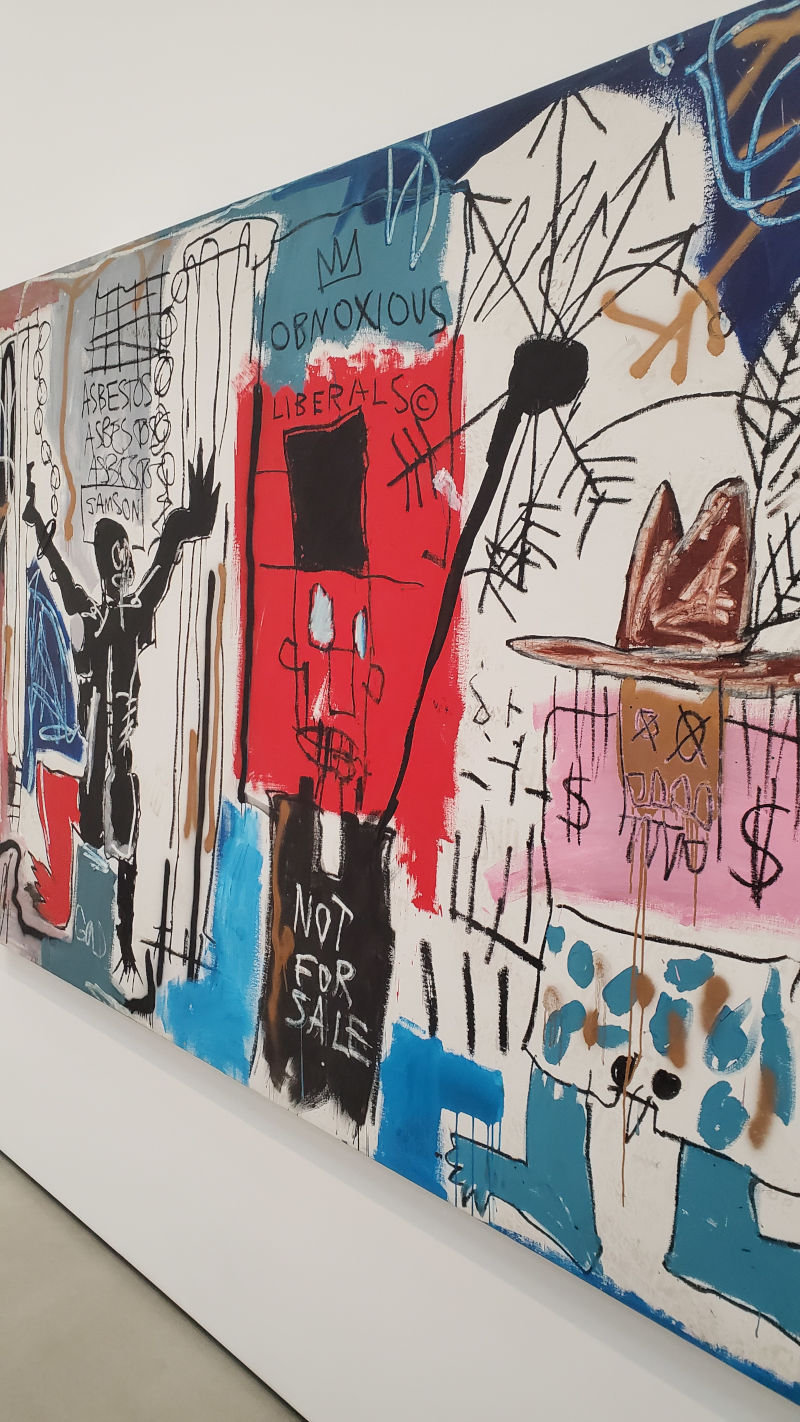 it was a paid exhibition, unfortunately, so i headed upstairs, horizons unexpanded by the infinity room. it turns out that the broad is where they had all of the artists i had wanted to see at the MOCA, and i saw quite a few of the paintings in person that i had just seen in books across the street down in the MOCA's reading room, including some ellsworth kellys. the highlight, though, was a piece that was just an enormous dining room table and chairs, tall enough to walk under with plenty of room to spare. so this is what a dog feels like, i thought. the table was a huge hit, everyone crowded around it to get pictures. it would be an excellent theme for a theme park, just making a bunch of huge stuff and let people wander around it.
it was a paid exhibition, unfortunately, so i headed upstairs, horizons unexpanded by the infinity room. it turns out that the broad is where they had all of the artists i had wanted to see at the MOCA, and i saw quite a few of the paintings in person that i had just seen in books across the street down in the MOCA's reading room, including some ellsworth kellys. the highlight, though, was a piece that was just an enormous dining room table and chairs, tall enough to walk under with plenty of room to spare. so this is what a dog feels like, i thought. the table was a huge hit, everyone crowded around it to get pictures. it would be an excellent theme for a theme park, just making a bunch of huge stuff and let people wander around it.
i noticed in the museum that they seemed to be making a big deal out of this artist basquiat, who i hadn't heard of before. suddenly, he was everywhere: there was a huge banner across the street advertising some kind of exhibition or tribute or something, the museum had a number of his works on display, and the gift shop had a ton of branded basquiat merch for sale. his actual art looked like a slapdash assortment of graffiti, although i can't deny that it had an aesthetic je ne sais quoi factor similar to pollack. i looked him up online and it seemed he was a pupil of warhol's, a young rockstar artist who made a ton of money selling paintings like the one at right to obnoxious liberals.
the los angeles central library
the LA central library is in a handsome historic building neighboring the biltmore, slyly extended deep underground during a nineties renovation. it was quite obvious from the architecture style, which a specialist might identify as utopian scholastic with elements of neoclassical pomo, the architectural equivalent of a cutting-edge pre-rendered 3d model of an ancient greek column from microsoft encarta '95. basically, the island of myst. there were plenty of other clues as well, like the logo for the young adult section "teenscape", which might as well have been a plaque declaring "DESIGNED IN THE NINETIES". the centerpiece of the addition was a deep atrium with escalators cascading down diagonally, whimsical chandeliers, and some tasteful columns running the whole height. on the top floor, a row of floor-to-ceiling windows offered a commanding view downwards into the atrium, and one broken pane was very noticeably cordoned off and encased in protective plywood. of course i idly wondered if someone had committed suicide by flinging themselves through it, but an inspection of the opposite side from another angle revealed no man-shaped hole, the pane still intact, cracked all over and bent slightly inwards. a failed attempt perhaps?
the library was fairly busy, though i didn't see a single person reading. the vast majority of the patrons seemed to be homeless people who came in to charge their phones and browse the internet. even the homeless aren't safe from smartphone addiction, i thought, and wondered if anyone has ever landed on the streets from that particular affliction.
brief bucket list update
devoted readers will recall that one of the items on my bucket list is seeing a space shuttle, one (of four) of which is located at the california science center in los angeles. i went to go see it one day, but OF COURSE the space shuttle exhibit happens to be undergoing major renovations for the foreseeable future so all i was able to see was a couple of big pointy things in the distance poking out of a mass of miscellaneous girders and scaffolding. foiled again...

USC
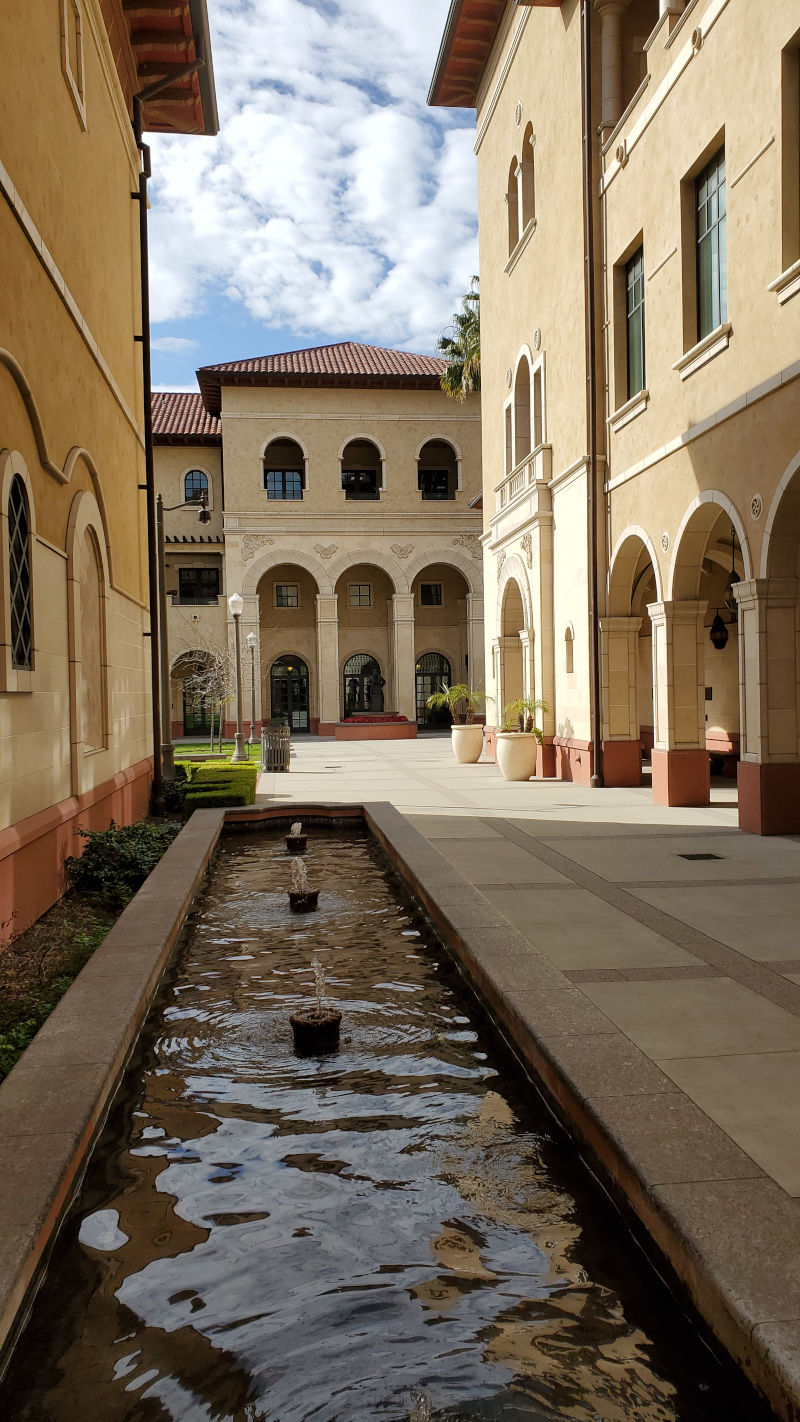 southwest of DTLA is USC, the university of southern california (to some, the "university of spoiled children"). stepping past its border walls and security booths, the contrast is so stark that it feels like entering a foreign country, a wealthy microstate governed by the Board of Trustees of the University of Southern California. it was spring break, so the campus was eerily quiet - vast walkways and seating areas totally abandoned. without any people around, i was really able to appreciate the campus design. the urban fabric feels totally different from the surrounding city, walkable and human-scaled, wide throughfares reserved for pedestrians and the occasional maintenance golf cart, the kind of urbanism the average american only experiences within a theme park. the architecture was beautiful, primarily done in a brick-besotted romanesque revival style, almost felt like being in a european city. above all else, the USC campus stood out because it was absolutely pristine. there wasn't a trace of trash anywhere, not even gumstains on the walkways, which looked like they had been powerwashed only moments ago. the bricks on even the oldest-looking buildings looked fresh from the kiln, bright and unbesmirched by any patina. every bush and every tree was perfectly trimmed, and the lawn on the "memorial quad" (every university has to have one) was so well manicured that i bent down and double-checked to make sure it wasn't fake. this, i suppose, is what the exorbitant tuition pays for: an army of janitors, landscapers, and powerwashers maintaining a city, the same way that well-to-do suburbanites maintain their houses.
southwest of DTLA is USC, the university of southern california (to some, the "university of spoiled children"). stepping past its border walls and security booths, the contrast is so stark that it feels like entering a foreign country, a wealthy microstate governed by the Board of Trustees of the University of Southern California. it was spring break, so the campus was eerily quiet - vast walkways and seating areas totally abandoned. without any people around, i was really able to appreciate the campus design. the urban fabric feels totally different from the surrounding city, walkable and human-scaled, wide throughfares reserved for pedestrians and the occasional maintenance golf cart, the kind of urbanism the average american only experiences within a theme park. the architecture was beautiful, primarily done in a brick-besotted romanesque revival style, almost felt like being in a european city. above all else, the USC campus stood out because it was absolutely pristine. there wasn't a trace of trash anywhere, not even gumstains on the walkways, which looked like they had been powerwashed only moments ago. the bricks on even the oldest-looking buildings looked fresh from the kiln, bright and unbesmirched by any patina. every bush and every tree was perfectly trimmed, and the lawn on the "memorial quad" (every university has to have one) was so well manicured that i bent down and double-checked to make sure it wasn't fake. this, i suppose, is what the exorbitant tuition pays for: an army of janitors, landscapers, and powerwashers maintaining a city, the same way that well-to-do suburbanites maintain their houses.
at one point, i went into a building billing itself as a library. a tourist activity i highly recommend is trying to enter random public-ish buildings, you never know what you'll find and you might be surprised how often you'll be let in. i pointed out once somewhere how nobody seems to go to campus libraries anymore to actually read books, "library" on campus has just become a byword for "quiet place to study". i suppose it was only a matter of time before someone decided to discard the pretenses (by which i mean the books) and make a "library" that's simply a building with a bunch of places to quietly sit and work, in solitary company. that's exactly what i found at that "library" on the USC campus, several floors with not a single bookshelf nor books, only a bunch of rooms with tables to sit and study at. the books had not yet been pushed out entirely, though: in a forgotten basement corner i found some of those space-saving rolling shelves housing a sparse selection of literary essentials.
yoshinoya
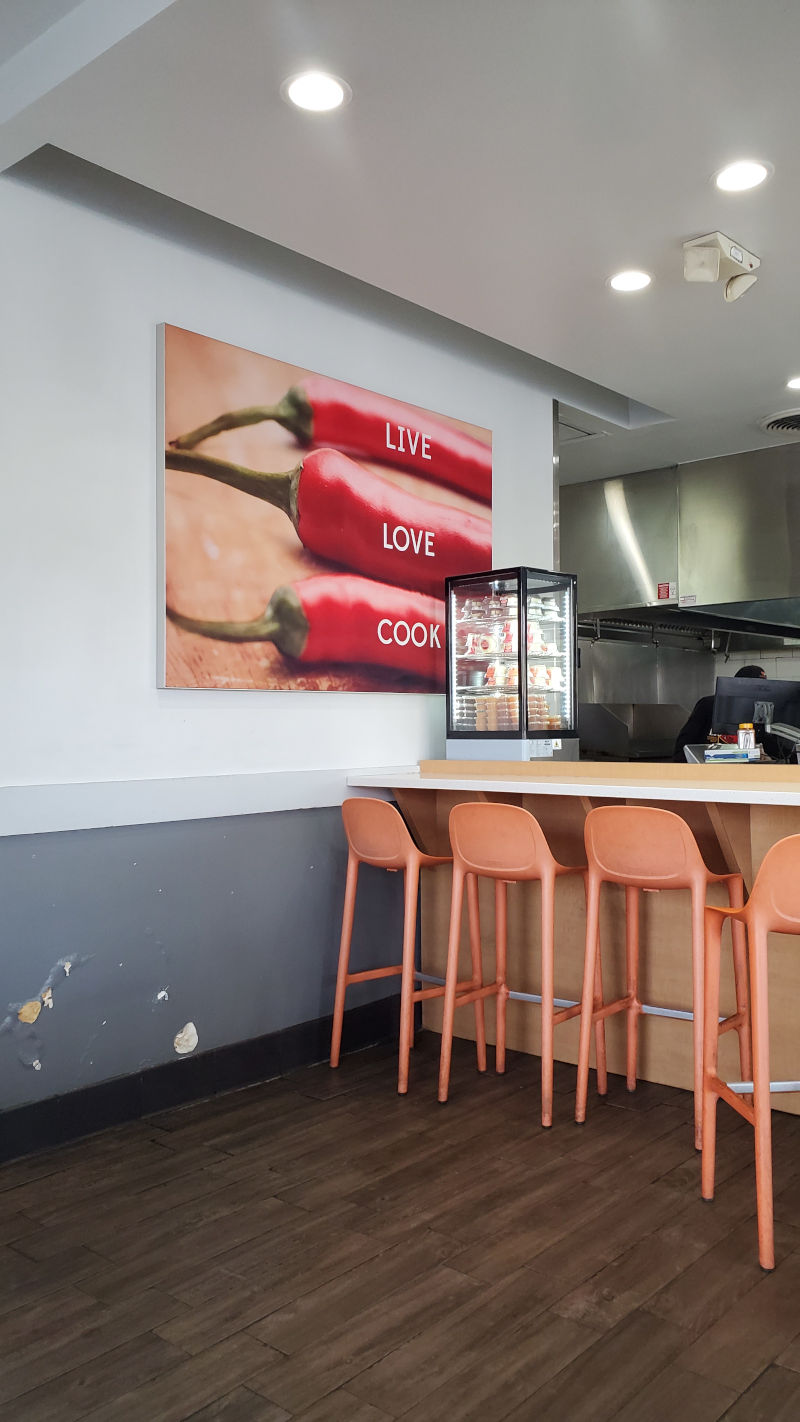 yoshinoya is the second-largest gyudon (beef bowl) chain in japan. like other large japanese chains, they've established a small foothold in the US, all located in socal. i had some good times in japanese yoshinoyas, like the time i opened a sophisticated disposable salad dressing container the wrong way and squirted it all over myself, to the amusement of everyone in the establishment (i wasn't even drunk at the time). there was one within convenient walking distance of USC, so out of curiousity about what the american branch looks like, i stopped by.
yoshinoya is the second-largest gyudon (beef bowl) chain in japan. like other large japanese chains, they've established a small foothold in the US, all located in socal. i had some good times in japanese yoshinoyas, like the time i opened a sophisticated disposable salad dressing container the wrong way and squirted it all over myself, to the amusement of everyone in the establishment (i wasn't even drunk at the time). there was one within convenient walking distance of USC, so out of curiousity about what the american branch looks like, i stopped by.
the clientele was an even mix of asian students who stayed behind for spring break and hispanic families who ordered at the counter in spanish, since all the staff were also spanish-speaking. the interior felt a bit uncanny, the area in front of the counter was slightly too spacious and the walls were decorated with aggressively generic graphics, stock photos overlaid with vague food-themed mantras. the menu seemed to have only about four things on it, of which i got the classic beef bowl and then threw in a side order of their new "tokyo fried chicken", since it was only $3 as part of some introductory promotion.
what i can say about the beef bowl is that although it wasn't awful, certainly a serviceable quick lunch slop bowl, it was not anywhere close to what they serve in japan. they had thin stringy (and most certainly inexpensive) slices of beef cooked with onions and soy sauce, and besides including rice that was where the similarities ended. it was served with a portion of steamed "veggies" that looked like they came straight from a frozen mix delivered by the trusty sysco truck, which i had encountered many times before in various "cafeterias".
the "tokyo" fried chicken, meanwhile, was really something. it came in a portion so generous for the amount i paid that it was frankly concerning, consisting of several monsterous bloated fried chunks that seemed too large to have come from any part of the chicken. who knew what kind of genetically-modified, steroid-enhanced fowl it was coming from, if it was even a bird in the first place. maybe they were tumorous outgrowths grown on chickens, harvested like grotesque fleshy fruits once large enough. underneath the fried coating, the mystery meat also had this odd sickly dark color to it, and although it tasted just fine i couldn't shake a sense of unease while eating it. it was almost enough to make me give up eating meat right then and there.
at one point during the meal, a passing bum stuggled to open the exit door, finally managed to poke his head in, yelled "FUCK YOU" to no one in particular, and then wandered off. later on, there was some drama because somebody in a beat-up maroon truck just parked it in the middle of the thin strip-mall parking lot upon finding it completely full, thereby blocking several vehicles in. on the walk back, not even a block away i encountered an asian nerd who appeared to be engaged in what i can only describe as hotwiring a wells fargo ATM, defended by a menacing sunglassed goon and right by a nearby sketchy white van, all in broad daylight with people passing by.
the LA metro
although the platforms themselves are usually appropriately sized, for some reason the entrances and tunnels leading down to many LA subway stations are way oversized, like they were designed for ten times the amount of people that actually use them, or perhaps originally built by an extinct race of subterranean giants. a few forgotten corners are decorated with objets d'art, surely intended to brighten the place up, but now they add to the creepiness because they look like they haven't been cleaned, let alone touched, in over 30 years. the design of the tunnels themselves is in a utilitarian (and now quite shabby) concrete-bedecked register i've decided to dub "urban megalithic brutalism". combined with how cavernous everything is, the overall effect is an almost overbearing oppressive atmosphere, trying to rub in your smallness in the face of the city. "you are just a cog in this vast machine that will grind you into dust," it proclaims. "wait, that doesn't make any sense - the grinding machine is grinding its own cogs into dust?" oh, but it makes perfect sense. SOCIETY.
the LA metro is another one of those de facto fare-optional transit systems, where you feel like a little bit of a chump paying up at the machine while people cruise through accessible faregates that are simply left open more often than not. metro employs a lot of "ambassadors" to stand around in the stations, but there's no need to worry because they do not do fare enforcement, in fact i'm not really sure what they do besides stand around like walmart greeters (one of them handed me a folded-up map of the system just barely larger than a postage stamp), always in groups of at least 2 or 3 chatting amongst each other. the other metro employees were all security of some sort, which i suppose is because the public transit system serves in part as a massive mobile homeless shelter - it feels as though every single tram or train car has an obligatory bum camped out in a far corner, stationed like a conductor or something. i'm not really sure what the security guys do either, though, because they certainly weren't doing fare enforcement or kicking out the homeless people. the only thing i ever saw them do was wake up a homeless guy sleeping in a corner when the train was waiting to leave at the terminus, the security guy said "look i won't kick you off but you just can't sleep on the train, okay? you better be awake when i come back..." when he came back five minutes later the guy had fallen back asleep, so he banged his flashlight on the window saying "WAKE UP, WAKE UP". i really cannot explain it.
crashing the LA marathon: a walk i'll never forgetty
unfortunately, the day we chose to go to the getty (probably the largest art museum in the world funded by a single guy [oil money]) coincided with the city's top traffic-disrupting event, the LA marathon (yes if you look up the date you'll realize it took me months to finally post this, now shut up and keep reading). this may not have been a problem, except that the marathon route lay directly between us and the getty. we had a little too much faith in the ability of LA public transit to surmount such an obstacle, and thus ended up waiting nearly an hour for a bus that never came. well, not exactly, the bus sort of came; we saw it park way down the road, walked over, and the driver told us that he was already running two hours behind and didn't know if he would even be driving that route. we waited a little bit for him to come by, but as the wait grew longer, many lost faith and the crowd slowly dwindled as ubers pulled up and whisked people away. then, at last, the bus came to life and came down, but as he pulled up the driver shook his head and changed the signs to "NOT IN SERVICE", stopping briefly to inform us that dispatch was sending him to the other end of the route and that the next bus would get us (we waited another 20 minutes and it never came). looking off into the distant hills, we could practically see our final destination, it really couldn't be THAT far away, so we decided to set off on foot.

 it was immediately obvious why the bus had never arrived: most of the main roads, down to the smaller arterials, were hopelessly congested, blocked up like the veins of a cardiac patient. tensions were running high in the streets, drivers honked and postured aggressively for slightly better positions within the morass. eventually, inevitably, we "ran" into it, the source of the delays, the roadblock setting drivers on edge across the city: the LA marathon. we joined the flow right at a water station, the road littered with an extraordinary amount of paper water cups discarded by runners in a hurry. by this point, it was quite late in the day and the race was far along, so the remaining numbered marathoners moving down the road in a steady flow looked languid and could not really be said to be "running" for the most part. it was mile 24, after all. as it turned out, the northerly route of the marathon coincided with the direction we needed to head in to reach the getty, so looking fresh and unconcerned beside the struggling stragglers, i ended up walking approximately one mile or so of the 2024 LA marathon. it was an odd feeling, walking in the middle of the four-lane stroad with no cars. today, i thought, the streets belong to the people (though we still stuck to the correct side of the road).
it was immediately obvious why the bus had never arrived: most of the main roads, down to the smaller arterials, were hopelessly congested, blocked up like the veins of a cardiac patient. tensions were running high in the streets, drivers honked and postured aggressively for slightly better positions within the morass. eventually, inevitably, we "ran" into it, the source of the delays, the roadblock setting drivers on edge across the city: the LA marathon. we joined the flow right at a water station, the road littered with an extraordinary amount of paper water cups discarded by runners in a hurry. by this point, it was quite late in the day and the race was far along, so the remaining numbered marathoners moving down the road in a steady flow looked languid and could not really be said to be "running" for the most part. it was mile 24, after all. as it turned out, the northerly route of the marathon coincided with the direction we needed to head in to reach the getty, so looking fresh and unconcerned beside the struggling stragglers, i ended up walking approximately one mile or so of the 2024 LA marathon. it was an odd feeling, walking in the middle of the four-lane stroad with no cars. today, i thought, the streets belong to the people (though we still stuck to the correct side of the road).
 navigating on foot towards the getty is easy enough at first, if you're close enough you don't even need a map because it's visible from quite a distance, a shining hilltop chateau. as we approached the hills, though, i started to feel once again (why does this always happen) like the only person in history to attempt reaching it on foot. the sidewalks grew overgrown and eventually fell away entirely, and soon we found ourselves playing chicken with speeding cars on the side of the road. it is fortunate that i chose a companion willing to walk an essentially unlimited distance over occasionally questionable terrain. just on the other side of the roadside fence we could see a car-free pedestrian utopia, regrettably closed off to us because it was one of those huge military cemeteries. they have a distinct aesthetic, strictly-regimented rows of ghostly glowing white standardized gravestones, evoking soldiers marching in formation. although they may have held different ranks in life, in death they are all equal. the sheer number of them, stretching out in a grid overlaid on the lawn into the distance, really makes you think that war has like, uhhhh, killed a lot of people, or something.
navigating on foot towards the getty is easy enough at first, if you're close enough you don't even need a map because it's visible from quite a distance, a shining hilltop chateau. as we approached the hills, though, i started to feel once again (why does this always happen) like the only person in history to attempt reaching it on foot. the sidewalks grew overgrown and eventually fell away entirely, and soon we found ourselves playing chicken with speeding cars on the side of the road. it is fortunate that i chose a companion willing to walk an essentially unlimited distance over occasionally questionable terrain. just on the other side of the roadside fence we could see a car-free pedestrian utopia, regrettably closed off to us because it was one of those huge military cemeteries. they have a distinct aesthetic, strictly-regimented rows of ghostly glowing white standardized gravestones, evoking soldiers marching in formation. although they may have held different ranks in life, in death they are all equal. the sheer number of them, stretching out in a grid overlaid on the lawn into the distance, really makes you think that war has like, uhhhh, killed a lot of people, or something.
the getty has only one public entrance, a little incovenient because it's not located right at the base of the hills, but requires going up a ways into a valley. i felt a bit like a peasant come to petition the king, performing the appropriate purification rituals in the gleaming antechamber facility in the valley. most of all, though, it reminded me of an airport: a huge parking lot, a long curbed area for rideshare pickups/dropoffs, a queueing area for a security check/ticket inspection, and then a platform where you wait to board the "tram" that goes up the hill (technically it is a people-mover because the vehicle has tires).
the antechamber/tram station was the first taste of "getty world" we encountered, an outpost down in the grimy "real" world. the fact that the only entrance to "getty world" was a white tram that takes you up a hill set my imagination racing, concocting all sorts of dystopian scenarios in which the elite retreat to their shining city on a hill while everything else burns below, access to their utopia strictly controlled by security forces guarding the only entrance, the tram station. one of the hero's hardest tasks will be, of course, figuring out how to sneak onto the tram and get up the hill to the compound. there must be at least five movies with basically that exact plot point.
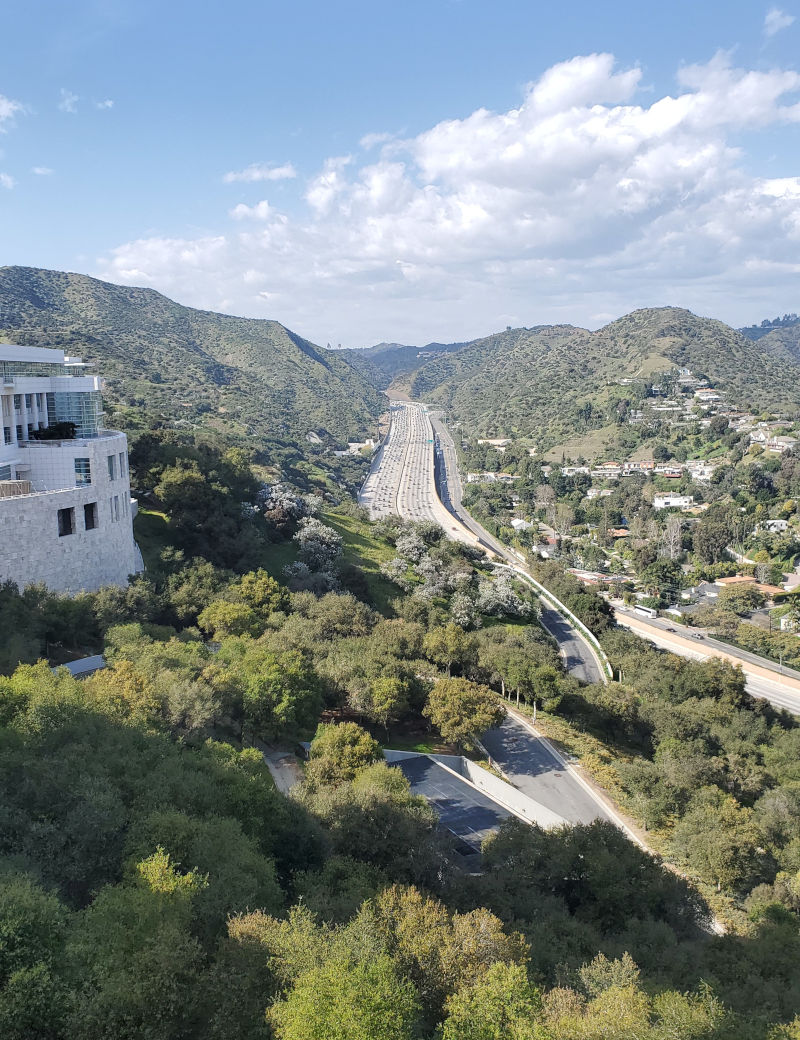 upon arriving at the getty proper atop the hill, my initial impressions were only reinforced. it was just so inpeccably clean, like the USC campus. even though it was nowhere close to that high, it felt like it was above the clouds, ethereal, or with its all-white facades perhaps a cloud itself. it has a distinct architectural style, indubitably modern and yet respecting tradition, huge blocks of imported italian travertine punctuated by concrete and glass. every balcony offered sweeping views of the city below, once again reinforcing the sensation of being upon an island floating above it all. unlike everyone else who had arrived by car, i think i felt it especially strongly, since i had actually walked through all of those rough areas that i was now looking back down upon from above. perhaps to them there was no disconnect between the getty and the city, where they were and what they had come from, because they had travelled seamlessly from the lobby of their luxury hotel to the flawless getty tram terminal at the foot of the fill, bypassing everything in between by experiencing it only as the interior of a car and the sides of the highway. to them, the rest of the city was only an abstraction, experienced only from behind the safety of glass or distance. perhaps they had visited an entirely different los angeles, a beautiful city consisting of pristinely-maintained hotel lobbies, delightful gourmet restaurants, curated museums, landscaped college campuses, everywhere the well-to-do frequent. little do they know that all along they've been isolated within their own archipelago, visiting islands of cleanliness and stability amidst a vast ocean of mad max disorder and poverty. perhaps my dystopian fantasy has already come to pass, the automobile as the getty tram for an entire metropolis. of the visitors, only i was able to fully appreciate the contrast, having personally waded through the city, the filth, to reach it... the entire getty center was itself a grand work of art, a vehicle built to convey secret truths specifically to me.
upon arriving at the getty proper atop the hill, my initial impressions were only reinforced. it was just so inpeccably clean, like the USC campus. even though it was nowhere close to that high, it felt like it was above the clouds, ethereal, or with its all-white facades perhaps a cloud itself. it has a distinct architectural style, indubitably modern and yet respecting tradition, huge blocks of imported italian travertine punctuated by concrete and glass. every balcony offered sweeping views of the city below, once again reinforcing the sensation of being upon an island floating above it all. unlike everyone else who had arrived by car, i think i felt it especially strongly, since i had actually walked through all of those rough areas that i was now looking back down upon from above. perhaps to them there was no disconnect between the getty and the city, where they were and what they had come from, because they had travelled seamlessly from the lobby of their luxury hotel to the flawless getty tram terminal at the foot of the fill, bypassing everything in between by experiencing it only as the interior of a car and the sides of the highway. to them, the rest of the city was only an abstraction, experienced only from behind the safety of glass or distance. perhaps they had visited an entirely different los angeles, a beautiful city consisting of pristinely-maintained hotel lobbies, delightful gourmet restaurants, curated museums, landscaped college campuses, everywhere the well-to-do frequent. little do they know that all along they've been isolated within their own archipelago, visiting islands of cleanliness and stability amidst a vast ocean of mad max disorder and poverty. perhaps my dystopian fantasy has already come to pass, the automobile as the getty tram for an entire metropolis. of the visitors, only i was able to fully appreciate the contrast, having personally waded through the city, the filth, to reach it... the entire getty center was itself a grand work of art, a vehicle built to convey secret truths specifically to me.
i was so struck with the symbolism of the getty center itself that i was barely able to pay attention to any of the art. it didn't help that the long walk in the sun beforehand left me hungry, fatigued, and possibly a bit delirious from not drinking enough. i shuffled mechanically from painting to painting thinking things like "stumbling upon nymphs bathing and getting turned into a stag... you don't see that happen much anymore..." i also think the collection just isn't that impressive in the first place, there isn't really a single iconic "showstopper" painting everyone knows and crowds around to take pictures of, the best you get is van gogh's "irises" (the impressionism room was by far the most crowded). obviously i'm all for hidden gems and underappreciated masterworks, but many famous paintings are famous for good reasons. they have a few other marginal works by very famous painters which people skip over, then read the caption and realize it's by edvard munch or somebody, and go back to look at/take a picture. the gardens were impressive, however, as it was the start of spring, the perfect time to see everything in brilliant bloom. once again, the greatest artist is of course God.